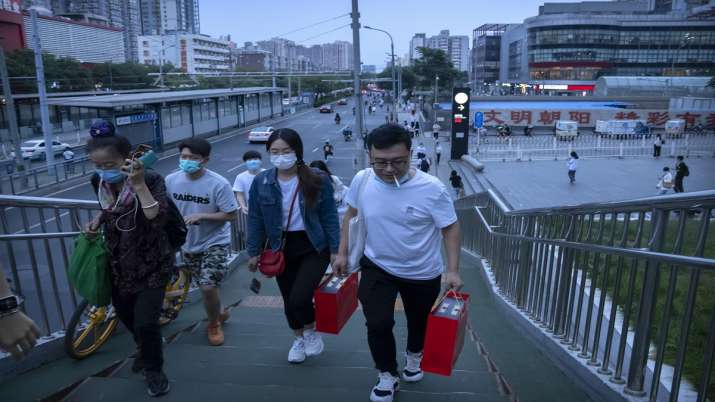Battling the worst coronavirus outbreak since it emerged in Wuhan two years ago, China on Monday acknowledged that its economy was hit by the Omicron variant leading to lockdowns of several cities as data showed the economy shrank dramatically in April, with experts warning that the decline is yet to bottom out.
China, which prides itself on stamping out COVID-19 after it broke out at Wuhan in December 2019 before it became a pandemic causing havoc around the world with millions of deaths, struggled to deal with the “Omicron Tsunami” in the last few months resulting in lockdowns of several cities including its business hub Shanghai besides capital Beijing, which is currently under semi-lockdown.
Officials in Shanghai on Monday announced that they will gradually open up Shanghai, China’s largest city of over 25 million people, from June 1, ending a two-month lockdown that brought the business-industrial hub to a grinding halt.
Shanghai has cut off the community transmission of COVID-19 in 15 out of its 16 districts, the local health commission said on Monday. The city reported 69 confirmed locally transmitted COVID-19 cases and 869 local asymptomatic cases on Sunday.
From June 1 to mid-late June, Shanghai will fully restore the normal order of production and life across the city with standard epidemic prevention and control measures, while strictly preventing any resurgence of the epidemic, Zong Ming, Vice Mayor, told the media.
The city which witnessed vocal public protests over the handling of the crisis by the government reported 582 deaths since March with thousands of people treated in make-shift hospitals.
Meanwhile, Beijing, which is under semi-lockdown, began a 3-day third round of testing of its 21 million people on Monday as the city remained in semi-lockdown for the third week to break the chain of the virus.
The lockdowns were meanwhile impacting the Chinese economy which is reeling under the Ukraine war and trade tensions with the US and the EU.
China's economy is expected to recover gradually as the country achieves major anti-epidemic outcomes and pro-growth policies take effect, Fu Linghui, spokesperson for the National Bureau of Statistics said on Monday as the 2nd largest economy took a hit from the three-month-long run of the Omicron variant of the COVID shutting several cities.
The economy is expected to improve in May with the accelerating resumption of work and production in Shanghai and Jilin as well as the implementation of pro-growth measures, Fu was quoted as saying by the official media.
According to the official data, China's April industrial production contracted by 2.9 per cent year-on-year, while retail sales were down 11.1 per cent, as the effects of Omicron flare-ups' disruptions on the economy further deteriorated.
This led to calls for a fine-tuning of China’s coronavirus policies, especially the firmly imposed zero-COVID policy and increased stimulus have grown louder as the April data showed the economy shrank dramatically.
Major indicators measuring China’s economy fell short of expectations with industrial production, retail sales, fixed-asset investment and the surveyed jobless rate falling to their weakest levels in more than two years.
“China’s economic activity contracted in April and was the most severe since the first quarter of 2020 during the first wave of the COVID outbreak,” Tommy Wu, lead China economist at Oxford Economics said.
Wu expects a contraction in the second quarter before returning to growth in the second half of the year. “The risks to the outlook are tilted to the downside, as the effectiveness of policy stimulus will largely depend on the scale of future COVID outbreaks and lockdowns,” he told the Hong Kong-based South China Morning Post.
The surveyed jobless rate of unemployment in China, which does not include figures for the nation’s tens of millions of migrant workers, rose to 6.
1 per cent in April, which is the second-highest record 6.2 per cent in February 2020.
The headline figures mean that China’s gross domestic product (GDP) fell by around three per cent from a year earlier in April, Ding Shuang, chief economist for Greater China and North Asia at Standard Chartered said.
China's economy grew at 4.8 per cent in the first quarter, falling below the 5.5 per cent target set for this year by the ruling Communist Party.
Cao Heping, an economist from Peking University, told state-run Global Times that the poor data in April reflected the drag caused by the epidemic, which was already shown in March and became more serious in April.
The epidemic's impact on Hong Kong and Shanghai as well as a large spillover was clear to see, as the two most dynamic economic regions in China, the Pearl River Delta and the Yangtze River Delta, were impacted, Cao said, noting the impact was carried over into May, he said.
Cao said the dual impacts meant that the downward pressure China faced in April is the most serious challenge since the first quarter of 2020, when the COVID-19 outbreak first hit Wuhan, Central China's Hubei Province.

